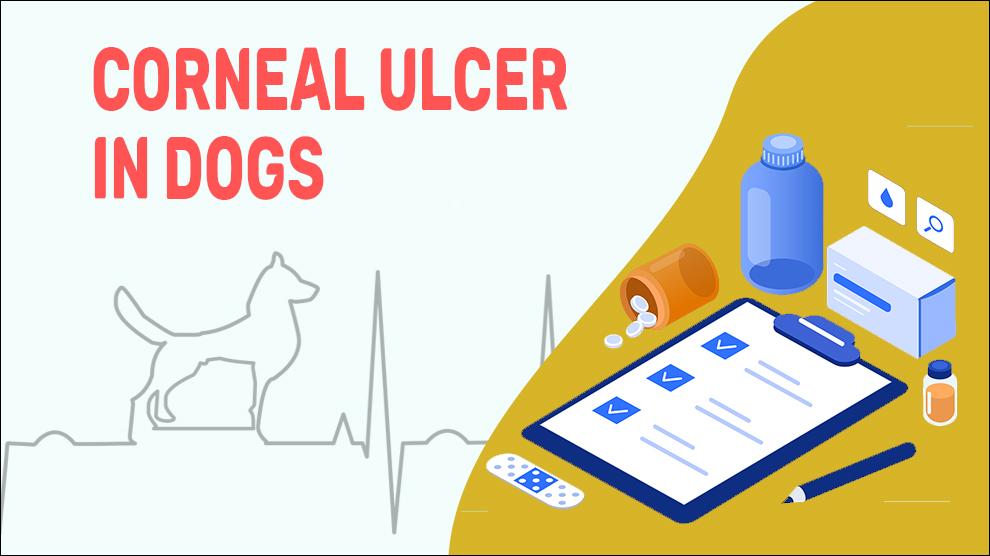* Petmoo is reader-supported. When you buy products via links on our site, we may earn an affiliate commission at no cost to you.
A canine corneal ulcer is an abrasion or erosion in the corneal (the clear layer in front of the pupil and iris) epithelium of the eye.
Corneal ulcers are usually painful, with or without ocular discharge and you may notice that your dog is pawing, rubbing at the eye, and squinting. There are different causes of corneal ulcers and trauma is the most common reason. They may result from scratching while exploring outside or rubbing their eye on the carpet, or due to a laceration or aggressively rubbing their eye or playing with another animal.
A dog is at higher risk for corneal ulceration if they have an underlying condition such as Entropion and trichiasis- abnormally placed eyelashes that are rubbing on the cornea or tear deficiency. Brachycephalic breeds such as bulldogs are at higher risk for corneal ulcers due to poor blink coverage over the cornea and increased exposure to the eye.
The good news is superficial ulcers and simple corneal abrasions heal within a week; however, if an ulcer becomes infected, it can rapidly develop into a perforation or deep wound and this type of ulcer may require specialized procedures to heal.
- Filmy, Cloudy appearance
- Irritated eyes/pawing at the eyes.
- Discharge, which may be yellow, green, or clear.
- Excessive tearing
- Sensitivity to light (photophobia).
- Swelling or closure of the eye.
- Swollen eyelids
Treatment Options
- Allergy medications: Anti-inflammatory (prednisolone or dexamethasone) or antihistamine medications.
- Antibiotics: For the application of the appropriate antibiotic treatment, an antibiogram should be performed (gentamicin, neomycin, Terramycin).
- Antibiotics such as amoxicillin, chloramphenicol, gentamicin, tobramycin, ciprofloxacin, oxytetracycline, etc.
- Eye pain and spasm- ophthalmic atropine ointment or drops.
- Surgical options: Grid keratectomy – Removal of poorly healing or dead layers of corneal tissue or a corneal graft is performed.
- For dry eye: Artificial tear drops – Artificial tear drops substitutes are hyaluronic acid, polyvinyl alcohol, polyvinyl pyrrolidine, and methylcellulose.
- Cyclosporine A (CsA), pimecrolimus, and tacrolimus – are noncytotoxic immunosuppressants.
Home Remedies
- When your dog is diagnosed with a corneal ulcer, ensure to follow precisely your vet’s medication instructions.
- Regularly monitor the symptoms and contact your vet if you note any significant new symptoms or changes in their vision.
Prevention
The best way to prevent Corneal ulcers is to maintain proper eye hygiene with behavioral training and products engineered specifically for dogs as well as to maintain overall health.
Affected Breeds
Pug, Boxer, Shih Tzu, Cavalier King Charles Spaniel, Bulldog, Airdale Terrier, Boston Terrier, Beagle, Bichon Frise, Chihuahua, Cocker Spaniel, Dachshund, German Shepherd, German Shorthaired Pointer, Irish Wolfhound, Poodle, Pekingese, Pembroke Welsh Corgi, Maltese, Shetland Sheepdog, Siberian Husky, Samoyed, Yorkshire Terrier, West Highland White Terrier
Additional Facts
- Risk factors:
- Blunt force trauma.
- Running through woods or heavy vegetation.
- Irritants such as debris/dust or shampoo.
- Bacterial or fungal infection (less common).
- lacerations including cuts or scratches by a sharp object.
- Certain breeds are more prone to corneal ulcers: Brachycephalic (flat-faced) breeds with prominent eyes.
- Partial-face paralysis
- Canine keratoconjunctivitis sicca (KCS).
- Infectious: Leishmania, canine distemper virus, etc.
- Types:
- Epithelial Corneal Ulcer – wound or scratches in the outer (upper) epithelial surface of the cornea.
- Stromal Corneal Ulcer – abrasions in the middle-stromal layer of the cornea.
- Endothelial Corneal Ulcer – sores that extend into the deepest (lowest) endothelial layer of the cornea and this is an indication of a bacterial infection.
- Mortality:
There is no mortality associated with corneal ulcers documented yet.
- Diagnosis:
- Serum biochemistry profile and complete blood count.
- Tonometry, slit lamp, and fundoscopy.
- Inner eye gonioscopy
- Biomicroscope
- Conjunctival cytology or biopsy
- Intraocular pressure testing
- Corneal stain testing
- Prognosis:
Prognosis often depends on the type and severity of the corneal ulcer. This is often positive with early diagnosis and appropriate treatment. Generally, corneal abrasions heal within four to five days.
Most dogs enjoy a pain-free life with careful attention and monitoring.
If the condition is not diagnosed earlier in the course of the disease or if it has progressed to deep corneal scarring, the pet may lose its vision or may not respond fully to the treatment.
When To See A Vet
Contact your vet right away, if you notice any of the following:
- Filmy, Cloudy appearance
- Irritated eyes/pawing at the eyes.
- Discharge, which may be yellow, green, or clear.
Food Suggestions
The diet should be included foods containing vitamins A, C, omega 3s, zinc, carotenoids, beta-carotene, lycopene, and antioxidants.
- Omega-3 oily fishes such as Salmon, Tuna, Cod, etc.
- Leafy greens such as Spinach, Kale, Watercress, etc.
- Nonmeat / plant protein sources such as Nuts, Lentils, Beans, Eggs, etc.
- Citrus fruits or juices, Sweet potatoes, Tomatoes, and Pumpkin.
- Zinc foods such as Pork, Tuna, and Oysters.
- Blueberries, Broccoli, Cabbage, Carrots, etc.
Conclusion
The extent of corneal injury dictates the complexity of the prognosis. Don’t miss the post-surgical eye checks once a month to check for any infection. And also follow all dosage instructions on prescribed medications. Use an Elizabethan collar for your dog to prevent self-trauma.
